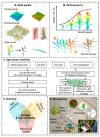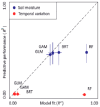A Comprehensive Review of LiDAR Applications in Crop Management for Precision Agriculture
- PMID: 39205103
- PMCID: PMC11360157
- DOI: 10.3390/s24165409
A Comprehensive Review of LiDAR Applications in Crop Management for Precision Agriculture
Abstract
Precision agriculture has revolutionized crop management and agricultural production, with LiDAR technology attracting significant interest among various technological advancements. This extensive review examines the various applications of LiDAR in precision agriculture, with a particular emphasis on its function in crop cultivation and harvests. The introduction provides an overview of precision agriculture, highlighting the need for effective agricultural management and the growing significance of LiDAR technology. The prospective advantages of LiDAR for increasing productivity, optimizing resource utilization, managing crop diseases and pesticides, and reducing environmental impact are discussed. The introduction comprehensively covers LiDAR technology in precision agriculture, detailing airborne, terrestrial, and mobile systems along with their specialized applications in the field. After that, the paper reviews the several uses of LiDAR in agricultural cultivation, including crop growth and yield estimate, disease detection, weed control, and plant health evaluation. The use of LiDAR for soil analysis and management, including soil mapping and categorization and the measurement of moisture content and nutrient levels, is reviewed. Additionally, the article examines how LiDAR is used for harvesting crops, including its use in autonomous harvesting systems, post-harvest quality evaluation, and the prediction of crop maturity and yield. Future perspectives, emergent trends, and innovative developments in LiDAR technology for precision agriculture are discussed, along with the critical challenges and research gaps that must be filled. The review concludes by emphasizing potential solutions and future directions for maximizing LiDAR's potential in precision agriculture. This in-depth review of the uses of LiDAR gives helpful insights for academics, practitioners, and stakeholders interested in using this technology for effective and environmentally friendly crop management, which will eventually contribute to the development of precision agricultural methods.
Keywords: LiDAR technology; autonomous harvesting systems; crop management; disease detection; precision agriculture; yield estimation.
Conflict of interest statement
The authors declare no conflicts of interest.
Figures



















Similar articles
-
Application of Precision Agriculture Technologies for Sustainable Crop Production and Environmental Sustainability: A Systematic Review.ScientificWorldJournal. 2024 Oct 9;2024:2126734. doi: 10.1155/2024/2126734. eCollection 2024. ScientificWorldJournal. 2024. PMID: 39421732 Free PMC article.
-
Deep learning-based prediction of plant height and crown area of vegetable crops using LiDAR point cloud.Sci Rep. 2024 Jun 28;14(1):14903. doi: 10.1038/s41598-024-65322-8. Sci Rep. 2024. PMID: 38942825 Free PMC article.
-
Exploring the link between soil health and crop productivity.Ecotoxicol Environ Saf. 2025 Jan 1;289:117703. doi: 10.1016/j.ecoenv.2025.117703. Epub 2025 Jan 13. Ecotoxicol Environ Saf. 2025. PMID: 39808880 Review.
-
Active and Passive Electro-Optical Sensors for Health Assessment in Food Crops.Sensors (Basel). 2020 Dec 29;21(1):171. doi: 10.3390/s21010171. Sensors (Basel). 2020. PMID: 33383831 Free PMC article. Review.
-
Designing and development of agricultural rovers for vegetable harvesting and soil analysis.PLoS One. 2024 Jun 21;19(6):e0304657. doi: 10.1371/journal.pone.0304657. eCollection 2024. PLoS One. 2024. PMID: 38905232 Free PMC article.
Cited by
-
Geometric Feature Characterization of Apple Trees from 3D LiDAR Point Cloud Data.J Imaging. 2024 Dec 31;11(1):5. doi: 10.3390/jimaging11010005. J Imaging. 2024. PMID: 39852318 Free PMC article.
-
Application of UAV remote sensing for vegetation identification: a review and meta-analysis.Front Plant Sci. 2025 May 30;16:1452053. doi: 10.3389/fpls.2025.1452053. eCollection 2025. Front Plant Sci. 2025. PMID: 40519599 Free PMC article. Review.
References
-
- Bongiovanni R., Lowenberg-DeBoer J. Precision Agriculture and sustainability. Precis. Agric. 2004;5:359–387. doi: 10.1023/B:PRAG.0000040806.39604.aa. - DOI
-
- Jin Y., Liu J., Xu Z., Yuan S., Li P., Wang J. Development status and trend of agricultural robot technology. Int. J. Agric. Biol. Eng. 2021;14:1–19. doi: 10.25165/j.ijabe.20211404.6821. - DOI
-
- Tahilyani S., Saxena S., Karras D.A., Gupta S.K. Deployment of autonomous vehicles in agricultural and using Voronoi partitioning; Proceedings of the 2022 International Conference on Knowledge Engineering and Communication Systems (ICKES); Chickballapur, India. 28–29 December 2022.
-
- Sparks A. Master’s Thesis. Michigan Technological University; Houghton, MI, USA: 2016. Use of LiDAR in the Design of Grassed Waterways: Case Study in Agricultural Management in Oklahoma.
-
- Di Stefano F., Chiappini S., Gorreja A., Balestra M., Pierdicca R. Mobile 3D scan LiDAR: A literature review. Geomatics, Natural Hazards and Risk. Geomatics. 2021;12:2387–2429.
Publication types
MeSH terms
Substances
Grants and funding
LinkOut - more resources
Full Text Sources

